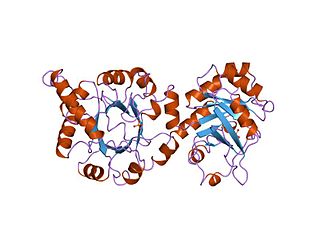
It has been suggested that this article be merged into Galactoside O-acetyltransferase . (Discuss) Proposed since June 2018. |
β-galactoside transacetylase is an enzyme coded for by the lacA gene of the lac operon, that transfers an acetyl group from acetyl-CoA to galactosides, glucosides and lactosides but not to the beta-galactosidase which is coded by lacZ in the lac operon of E. coli . [1] The galactoside acetyltransferase of the classical E.coli lac operon is an enzyme whose biological role remain unclear. [1] Its precise function as part of the lac operon is not understood currently. [2]

Enzymes are macromolecular biological catalysts. Enzymes accelerate chemical reactions. The molecules upon which enzymes may act are called substrates and the enzyme converts the substrates into different molecules known as products. Almost all metabolic processes in the cell need enzyme catalysis in order to occur at rates fast enough to sustain life. Metabolic pathways depend upon enzymes to catalyze individual steps. The study of enzymes is called enzymology and a new field of pseudoenzyme analysis has recently grown up, recognising that during evolution, some enzymes have lost the ability to carry out biological catalysis, which is often reflected in their amino acid sequences and unusual 'pseudocatalytic' properties.

The lac operon is an operon required for the transport and metabolism of lactose in Escherichia coli and many other enteric bacteria. Although glucose is the preferred carbon source for most bacteria, the lac operon allows for the effective digestion of lactose when glucose is not available through the activity of beta-galactosidase. Gene regulation of the lac operon was the first genetic regulatory mechanism to be understood clearly, so it has become a foremost example of prokaryotic gene regulation. It is often discussed in introductory molecular and cellular biology classes for this reason. This lactose metabolism system was used by François Jacob and Jacques Monod to determine how a biological cell knows which enzyme to synthesize. Their work on the lac operon won them the Nobel Prize in Physiology in 1965.

In organic chemistry, acetyl is a moiety, the acyl with chemical formula CH3CO. It is sometimes represented by the symbol Ac (not to be confused with the element actinium). The acetyl group contains a methyl group single-bonded to a carbonyl. The carbonyl center of an acyl radical has one nonbonded electron with which it forms a chemical bond to the remainder R of the molecule. In IUPAC nomenclature, acetyl is called ethanoyl, although this term is rarely heard. The acetyl moiety is a component of many organic compounds, including acetic acid, the neurotransmitter acetylcholine, acetyl-CoA, acetylcysteine, acetaminophen (also known as paracetamol), and acetylsalicylic acid (better known as aspirin).
Contents
The kinetics of the enzyme were delineated in 1995. [3]
The enzyme's cellular role may be to detoxify non-metabolizable pyranosides by acetylating them and preventing their reentry into the cell. [4]










